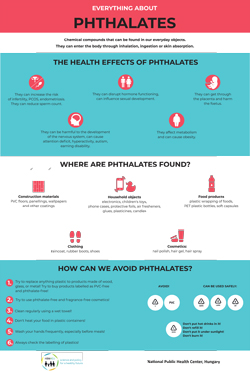 PHTHALATES are compounds used primarily as plasticisers as they increase the flexibility and service life of plastics. They do not form strong chemical bonds, so they can be released for a long time from the various products. Phthalates can occur in many products we use daily. Products made of flexible plastics (PVC) or rubber (e.g.: PVC-floors, carpets, cables, the plastic handles of tools, stickers) all can contain phthalates. The plastic packaging of food products can also contain these chemicals; therefore, they can enter our body if we consume food that came into contact with these materials. They can also get into the liquids contained in bottles made of polyethylene terephthalate (PET). They are also used in cosmetics (e.g.: nail polish, hair spray) as plasticisers and fixatives in fragrances so they can be absorbed through the skin or we may also inhale them. Certain clothing items made of plastic (e.g.: shoes, rain-coats) could also contain phthalates. There are many other sources of phthalates, they can also be found in modelling clays, glues, paints, air fresheners, candles, protective foils and soft capsules. They are also present in settled dust and in the indoor air. The use of certain phthalates in certain products (e.g.: children’s toys) is already limited in the EU.
PHTHALATES are compounds used primarily as plasticisers as they increase the flexibility and service life of plastics. They do not form strong chemical bonds, so they can be released for a long time from the various products. Phthalates can occur in many products we use daily. Products made of flexible plastics (PVC) or rubber (e.g.: PVC-floors, carpets, cables, the plastic handles of tools, stickers) all can contain phthalates. The plastic packaging of food products can also contain these chemicals; therefore, they can enter our body if we consume food that came into contact with these materials. They can also get into the liquids contained in bottles made of polyethylene terephthalate (PET). They are also used in cosmetics (e.g.: nail polish, hair spray) as plasticisers and fixatives in fragrances so they can be absorbed through the skin or we may also inhale them. Certain clothing items made of plastic (e.g.: shoes, rain-coats) could also contain phthalates. There are many other sources of phthalates, they can also be found in modelling clays, glues, paints, air fresheners, candles, protective foils and soft capsules. They are also present in settled dust and in the indoor air. The use of certain phthalates in certain products (e.g.: children’s toys) is already limited in the EU.
There are several phthalates that are known to disturb the hormone system especially during the foetal, infant, and child development. They can alter sexual development and function (resulting in early puberty, cryptorchidism, urinary tract disorders, reduced sperm count, reduced fertility, polycystic ovary, and endometriosis). They can be harmful to the development of the nervous system (causing delays in neurodevelopment, learning difficulties and disorders like ADHD and ASD) and can cause metabolic disorders. Most phthalates are quickly broken down in the body into simpler components and are then excreted from the body. The extent of the phthalate exposure can be shown from the urine.
Phthalates can be avoided with careful attention. Products made of natural materials should be selected over those made of plastic and we should also prefer products labelled as PVC-free, phthalate free, and fragrance free. Exposure can be reduced by using fewer cosmetic products, this is especially important for pregnant women and mothers of infants. Household dust can also contain these compounds, so their concentration can be further reduced by regular cleaning and dusting with a wet towel. Phthalates release more easily on higher temperatures; therefore, warming food in plastic containers should be avoided. Frequent and thorough handwashing, especially prior to eating, is also good practice. The most important measures; however, are to check the labelling of plastic products and to use plastics that are considered safe.







